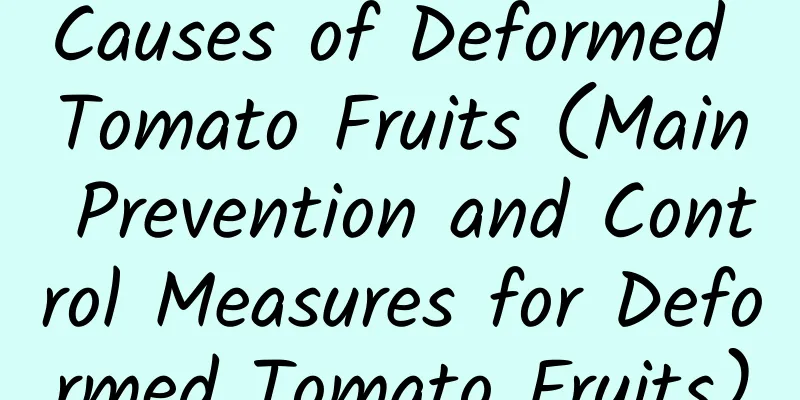Causes of Deformed Tomato Fruits (Main Prevention and Control Measures for Deformed Tomato Fruits)

1. Tomato flower bud differentiation problemThere are two types of poor flower bud differentiation in tomatoes: excessive flower bud differentiation and incomplete flower bud differentiation. The fruits formed by deformed flowers are all deformed fruits. The main reason for the formation of deformed flowers is that the temperature is too high or too low during the differentiation of flower buds in the seedling stage . When tomatoes grow 2 to 7 true leaves, they differentiate into 1 to 3 spikes of flowers, 8 to 11 leaves differentiate into 4 to 6 spikes of flowers, and 12 leaves differentiate into 7 or more spikes of flowers. If the night temperature in the greenhouse is below 10 degrees for a long time in winter and spring, abnormal cell development will cause excessive differentiation and incomplete differentiation. A normal tomato flower has 5-7 petals. Flowers with more than 8 petals have excessive flower bud differentiation and can grow into overly large, multi-ventricular, deformed fruits. Sufficient water and excessive nitrogen fertilization can also easily lead to excessive differentiation of flower buds and produce deformed fruits. Fruits formed by incomplete flower bud differentiation are prone to cracking at the top, exposing the seeds from the ventricle, becoming dehiscent fruits. The lack of trace elements such as calcium and boron can lead to poor differentiation of flower buds and cause deformed fruits. 2. Affected by different concentrations of dipping liquidIn order to increase the fruit setting rate, 2,4-D or tomato spirit is generally used for flower dipping treatment in production. If the concentration is not used properly, especially when the concentration is too high or the flowers are dipped repeatedly, the tomato fruit will develop abnormally and pointed fruits are likely to appear . If the temperature is too high when dipping the flowers, it is also easy to cause the concentration of the dipping liquid to be too high, resulting in deformed fruits. What measures should be taken to prevent the occurrence of deformed fruit?1. When planting in greenhouses in winter, choose varieties that are resistant to low temperatures and weak light , so that deformed fruits are less likely to occur. 2. Do a good job of regulating the temperature in the greenhouse to provide good conditions for flower bud differentiation. The greenhouse temperature should be 20-30℃ during the day and 12-15℃ at night. Avoiding low night temperatures can effectively prevent poor flower bud differentiation. 3. Apply fertilizers reasonably to ensure the supply of nitrogen, phosphorus, potassium, calcium, boron and other major, medium and trace elements to meet the needs of crop growth. 4. Accurately master the dipping technique . Strictly control the dipping concentration. Slightly reduce the concentration when the temperature is high, and increase the concentration appropriately when the temperature is low. Do not dip the flowers repeatedly; the best time to dip the flowers is the day when the tomatoes bloom. It is not good to dip them too early or too late. 5. When deformed fruits are found, they should be removed in time to avoid competition for nutrients and affecting the normal development of flowers and fruits. |
<<: When to harvest winter cabbage (how to harvest and store winter cabbage)
>>: What's the matter with the golden edges on cucumber leaves?
Recommend
Top 10 Most Beautiful Succulent Plants
1. Orange Monroe Orange Monroe has a cute appeara...
How to prune northern grapes, winter pruning time
1. How to prune 1. Pruning length: When pruning, ...
The efficacy and function of neem tree
economy Neem is a very good wood. The material is...
The correct way to repot a fortune tree
The reason why the money tree is favored by many ...
When to sow and raise cucumber seedlings?
Cucumber is a common vegetable that likes warmth....
Clivia cultivation methods and precautions, how to grow Clivia
1. Breeding methods 1. Watering: It has strong dr...
How to grow white peony until it overflows the pot
The simplest and most brutal way to make a pot bl...
How many years does it take for a chestnut tree to bear fruit?
After several years of planting, chestnut trees b...
How to care for primroses
Lighting conditions Primroses prefer a warm and s...
The easiest way to raise pigs
Pig farming is a popular breeding industry and it...
What to do if hyacinth is pinched by an arrow
1. Reasons 1. Low temperature Hyacinthus generall...
How to cultivate Milan flowers to grow well
Milan flower growing conditions Milan prefers a w...
Can lotus seeds be eaten? Are there any benefits to eating lotus seeds?
1. Can lotus seeds be eaten? Fruit will grow in t...
What kind of soil do orchids like? Do they prefer acidic soil or alkaline soil?
1. What kind of soil do you like? Orchids like sl...
What fertilizer is best for peony flowers?
Peony flower fertilization time When planting peo...









